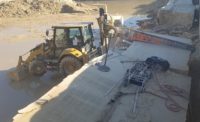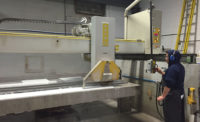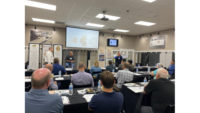What are the best practices for fabrication shop safety? How do you ensure that complacency doesn’t exist in your company? It might be best to first understand what areas fabricators are being cited the most for inadequate procedures or hazards. Last year, both the U.S. Occupational Safety and Health Administration (OSHA) and the Ministry of Labour (the OSHA equivalent in Canada) cited the following as key concerns:
- Respiratory Protection
- Hazard Communication
- Powered industrial trucks
- Occupational noise exposure
- Wiring methods, components and equipment for general use
- Air contaminants
- General requirements
- The control of hazardous energy (lockout/tagout)
- Sanitation
- Slings
Here is what the inspector will look for:
• Hazcom program - Often the first thing an inspector will look for during an inspection is a written Hazard Communication (Hazcom) program or Workplace Hazardous Materials Information System (WHMIS) program in Canada. This documentation tells what kinds of hazardous materials are in the building.
• SDS Sheets - The inspector will want to see a written policy on labeling procedures, a Safety Data Sheet (SDS) for each chemical on-site, and employee safety training and standards logs.
• Hazcom meetings (or WHMIS meetings in Canada) - These must be held whenever a new hazardous condition occurs or a new hazardous material is introduced into the workplace. Every new employee must be given a Hazcom briefing prior to going into an area where hazardous materials are present. Failure to provide employees with information and training on hazardous chemicals will result in an inspection citation in nearly all cases. Therefore, Hazcom recordkeeping is crucial.
• Safety meeting logs - They must be kept and outline the date, time, subject matter covered and who conducted the training. There also must be a sign-in roster listing the meeting attendees.
• Hearing Tests - A company needs to keep a record of baseline hearing tests for each worker in the shop. OSHA will take a close look at residual hearing loss testing and tracking. If a company is required to participate in the Hearing Conservation Program, it will be required to conduct annual hearing tests and annual training for all employees within the program.
• Certifications - A company will be asked to provide documentation on training for such specialists as forklift and overhead crane operators, as well as current certification and operating permits for all equipment of this kind.
• Safety Notices - The inspector will look for posted safety notices for employees and will record whether they are in English, Spanish and/or other languages.
• Electrical Conductors - The inspector will thoroughly inspect electrical conductors. Citations can result if there is no protection of connectors going into boxes, cabinets or fittings.
• Electrical Covers - Missing or broken electrical covers and/or canopies are a violation. Test all electrical outlets to ensure they are properly grounded. Covers and canopies can be fixed if they are spotted during an inspection. Ground Fault Circuit Interrupter (GFCI) protection is mandatory for many circuits in the shop (consult local codes).
• Electrical Cord Use - Inspectors will focus on improper use of electrical cords, residential cords being used in the workplace and cords that are not approved by the American National Standards Institute (ANSI) or Canadian Standards Association (CSA) in Canada. As mentioned, electrical outlets should be changed to GFCI, if they are not that type now. Because water is an important component in stone shop operations, the type of electrical outlets and use of cords is a critical issue.
• Guards - They should always be placed close to grinding wheels. Safety glasses should be nearby, with a printed safety warning to always wear them when using grinders. No machine on the shop floor should be operated without a safety guard.
• Hard Hats - They must be compliant to standards set by ANSI or CSA in Canada. Inspectors will look for their use on commercial and residential construction sites or in areas where overhead cranes are in operation.
• Fall Protection -Inspectors will look for insufficient protection against falls in the workplace. All working surfaces 6 feet and higher from ground level must have guardrails, safety nets or other fall protection systems.
• Fire Extinguishers - Inspectors will want to verify the existence and location of an adequate number of ABC-rated fire extinguishers in the shop. Generally, a fire extinguisher should be placed every 50 feet within the workplace. Fire extinguishers are also required on all trucks and forklifts and on jobsites as well. The OSHA inspector will look for documentation of a fire safety escape plan and escape route. Fire extinguishers require monthly inspections and other inspections by a qualified person.
In Canada, these extinguishers must have an Underwriters’ Laboratories of Canada 4A40BC rating. Additionally, The Industrial Establishments Reg. 851, which points to the Fire Code for fire extinguisher requirements, may apply to shops.
• OSHA Form 300 & 301 Logs - Be sure to have an updated OSHA Form 300 log and any copies on file that list work-related injuries and illnesses. This log should be updated daily, if possible. You will also need to have OSHA Form 301 reports for the past five years. OSHA inspectors require that these records be available for review when they come for inspections.
In Canada these are referred to as Accident and Injury Notifications - Written notice of occurrences containing the prescribed information and particulars must be made in accordance with the OSH Act. Be sure to have an updated log and any copies on file that list work-related injuries and illnesses. This log should be updated daily, if possible. Inspectors (directors) require that these records be available for review when they come for inspections.
• Personal Protection Equipment - A major part of the inspection will include examining the personal protection equipment (PPE) used by employees in the facility. This includes ANSI-approved (or CSA-approved in Canada) safety glasses for eye protection, ear plugs, ear muffs and noise-canceling headphones for hearing protection, face masks and other devices for respiratory protection, safety-toe shoes to protect against falling material, safety barrier windows on machines, safety gloves, safety harnesses for use on lifts, protective aprons and wet suits and protective rubber boots.
• Cleanliness -The cleanliness of the shop is important, including elements of dust containment and the amount of dust allowed to accumulate.
• Safety Indicators – The inspector will look at other safety indicators, such as the location of safety boundary markers, LP gas tank containment and hazardous material storage. Every facility should have an appropriate fireproof cabinet for flammable materials. If you see anything that appears to be a potential hazard, contact your supervisor immediately. Wear the proper personal safety equipment wherever indicated and keep a neat workspace at all times.
Of course, one thing that a government inspector cannot possibly determine in a visit is the overall safety awareness of the people in the shop. Although attention to all of the safety tips covered in this article, coupled with the general cleanliness of the facility, tell a lot about a company’s attention to safety details.
Safety meeting logs, frequency of meetings, attendee logs and the subject matter addressed will immediately tell an inspector how diligently management works to build and maintain safety awareness among its employees. Creating an atmosphere in which safety awareness is “second nature” among every person working in the stone facility should be every company’s goal.
“The key to building safety awareness is to make people think about safety and what can go wrong virtually every minute of the working day,” said Ara Movesian of Bedrosian.
“We are dealing with a very dangerous material, and there is no room for complacency,” said Victor Almeida, general manager of Texas-based Interceramic Marble Collection.
The bottom line for making a good impression when an inspector comes calling is to pay attention to the details as outlined in this article and to demonstrate that you are operating a safe facility and continually educating the workforce on safety issues.
There are many sources for general safety information — ranging from government regulatory websites to your insurance carrier. Additionally, the vast majority of the resources available from the Marble Institute of America (MIA) has been tailored to fit the stone industry so that stone employees can directly relate to the content. For more information on MIA’s wide-ranging safety initiative, go online to
www.marble-institute.com/safety.





